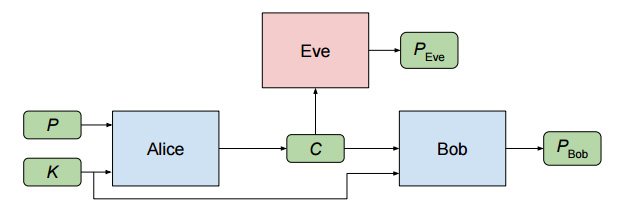Google Brain has created two artificial intelligences that evolved their own cryptographic algorithm to protect their messages from a third AI, which was trying to evolve its own method to crack the AI-generated crypto. The study was a success: the first two AIs learnt how to communicate securely from scratch.
Importantly, the AIs were not told how to encrypt stuff, or what crypto techniques to use: they were just given a loss function (a failure condition), and then they got on with it. In Eve's case, the loss function was very simple: the distance, measured in correct and incorrect bits, between Alice's original input plaintext and its guess. For Alice and Bob the loss function was a bit more complex: if Bob's guess (again measured in bits) was too far from the original input plaintext, it was a loss; for Alice, if Eve's guesses are better than random guessing, it's a loss. And thus an adversarial generative network (GAN) was created.
Alice, Bob, and Eve all shared the same "mix and transform" neural network architecture, but they were initialised independently and had no connection other Alice and Bob's shared key. For Alice the key and plaintext are input into the first layer of the neural network; for Bob the key and the ciphertext were input; and for Eve, she got just the ciphertext. The first layer is fully-connected, so the text and key can mix about. Following the first layer there are a number of convolutional layers, which learn to apply a function to the bits that were handed to it by the previous layer. They don't know what that function might be; they just learn as they go along. For Alice, the final layer spits out some ciphertext; Bob and Eve output what they hope is the plaintext.

The results were... a mixed bag. Some runs were a complete flop, with Bob never able to reconstruct Alice's messages. Most of the time, Alice and Bob did manage to evolve a system where they could communicate with very few errors. In some tests, Eve showed an improvement over random guessing, but Alice and Bob then usually responded by improving their cryptography technique until Eve had no chance (see graph).
The researchers didn't perform an exhaustive analysis of the encryption methods devised by Alice and Bob, but for one specific training run they observed that it was both key- and plaintext-dependent. "However, it is not simply XOR. In particular, the output values are often floating-point values other than 0 and 1," they said.
In conclusion, the researchers—Martín Abadi and David G. Andersen—said that neural networks can indeed learn to protect their communications, just by telling Alice to value secrecy above all else—and importantly, that secrecy can be obtained without prescribing a certain set of cryptographic algorithms.
There is more to cryptography than just symmetric encryption of data, though, and the researchers said that future work might look at steganography (concealing data within other media) and asymmetric (public-key) encryption. On whether Eve might ever become a decent adversary, the researchers said: "While it seems improbable that neural networks would become great at cryptanalysis, they may be quite effective in making sense of metadata and in traffic analysis."

You must login or create an account to comment.